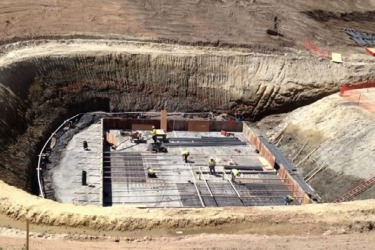The child’s game of Tiddlywinks demonstrates the principles of eccentric loads. When certain property and design limitations result in offset centers of gravity between a column or wall and its footing pad, you need to engage a balancing act. Otherwise, your footings can tilt or overturn after the fashion of a Tiddlywink disk bearing pressure on its edge. One potential answer may come in the form of balanced or cantilever footings.
WHAT IS A BALANCED OR CANTILEVER FOOTING?
If, for whatever reason, a perimeter column support must be placed eccentrically (off center) on its spread footing, or the quality of the soil will cause differential settlement, you can obtain balanced pressure on the footings by connecting them to an interior footing with a tie, or strap, beam. Usually composed of reinforced concrete (as opposed to a steel beam), the tie or strap beam connects both footers and provides the needed stability. When the superstructure loads are applied, the beam distributes the pressure between the footings so that the combined load becomes shared, thus balanced, between them.
The rigidity of the tie beam resists bending from the tilting action of one or both footers, thus transferring the weight of each column evenly to the soil through the footers. Because its purpose is to cause both supports to carry weight together, the beam itself does not bear loads. To avoid the upward pressure of the soil on the tie beam, it should either rest on loosened soil or be placed a few inches above the soil.
As a type of combined footing under two or more columns, strap beams can be engineered as a unit with the footers or separately, as building conditions dictate.
WHAT CONDITIONS MIGHT CALL FOR FOOTINGS WITH TIE BEAMS?
Several circumstances could call for cantilever or balanced footings:
1. LIMITED SPACE FOR FOUNDATION FOOTINGS
Urban build-out and renovations can mean tight spaces for construction. When you need to place your supports right up against the next building, immovable service runs or property lines, and have no space to pour a full footing, balanced footings offer one possible answer.
2. RETAINING WALLS
Facing the same limits of footing space, you may choose to build a retaining wall foundation instead, which introduces shear pressures from the ground into the calculations. The soil from the adjoining property may not bear down in a perfectly parallel direction to your wall, threatening to overturn or push on your wall and its footer. Strapping the wall footer to the interior column footers can counteract the stresses against the foundation.
3. POOR OR UNEQUAL SOIL BEARING CAPACITY
If you can’t trust the substrate to adequately bear the anticipated loads, but your space prevents some larger pad footings, you can connect one smaller footing — whether eccentric or not — to a larger footing to properly achieve the load transfer to the soil. Also, if you have poor soil under one footing but perfectly adequate soil beneath another, the tie beam should neutralize the settlement differences.
4. WIDELY-SPACED COLUMNS
Where continuous footers become infeasible due to the distance between columns, balanced footers can fill the bill. Because long distances increase the bending moment on the continuous footer, it may work better to connect the perimeter support footers to those of closer interior columns.
5. CANTILEVER SUPERSTRUCTURES
If the supported building will have elements extending well beyond the outer columns, cantilevered structural concrete footings can help countervail the diagonal loads.
Solutions exist for nearly every architectural engineering problem you encounter. Could balanced or cantilever footings cure the difficulties with your project? Bring your plans to the experts at Barton Supply, your go-to Front Range concrete construction supplier. We can help you create the perfect reinforced concrete foundation and footing design to give your structure the strength it needs for endurance over time. Call us today!
